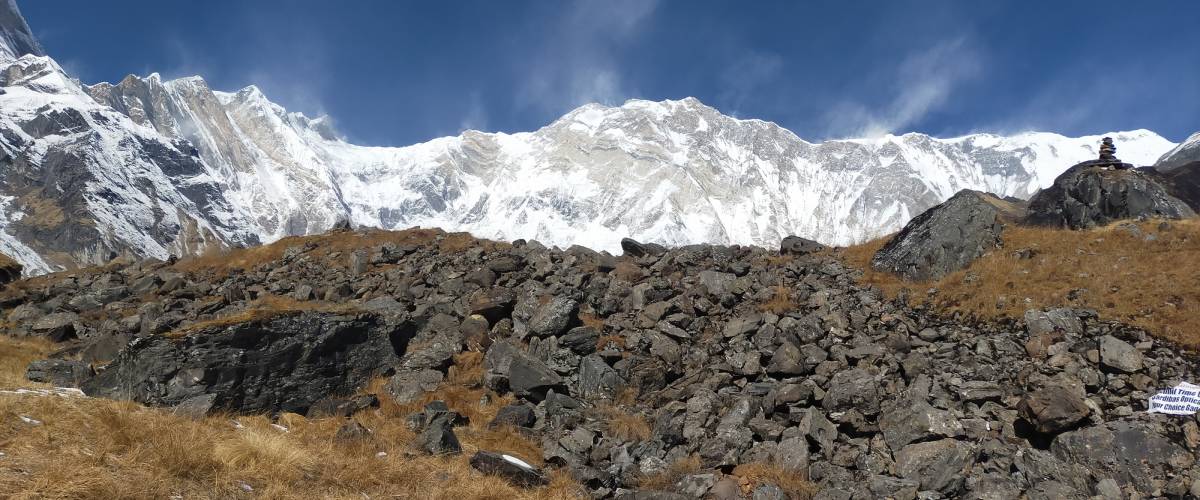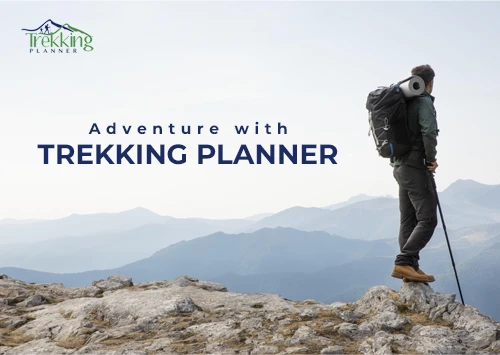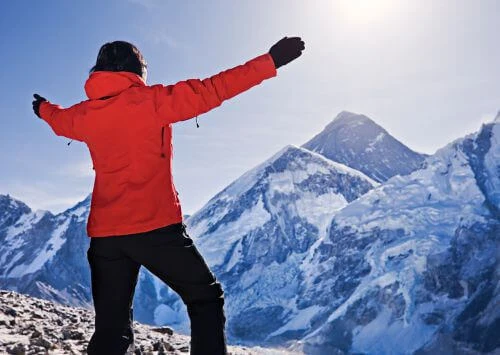Ready for an adventure? Trek to Annapurna Base Camp in April and witness the stunning beauty of spring in the Himalayas. Get all the details here.
If you're looking for a thrilling adventure this spring, consider trekking to Annapurna Base Camp in April. This is the perfect time to witness the stunning beauty of the Himalayas in full bloom, with clear skies and mild temperatures. Here's everything you need to know to plan your trip.
April is the best time to trek to Annapurna Base Camp.
For several reasons, April is the best time to trek to Annapurna Base Camp. First, the weather is mild and clear, with temperatures ranging from 10-15°C during the day and -5 to 0°C at night. This makes for comfortable trekking conditions and excellent visibility of the surrounding mountains. Second, April is the start of spring, which means the rhododendron forests are in full bloom, creating a stunning display of pink and red flowers. Finally, April is a less crowded time to trek than the peak season in October so that you can enjoy the beauty of the Himalayas in a more peaceful setting.
- Weather: In April, the weather is mild and dry, making it an ideal time to trek. The skies are generally clear, providing stunning views of the surrounding mountains. The daytime temperature is pleasant, averaging around 15-20 degrees Celsius, while the nighttime temperature can drop to around -5 degrees Celsius. The weather conditions in April make it easier for trekkers to acclimatize to the altitude and enjoy the trek without worrying about harsh weather conditions.
- Spring Season: April falls in the spring season in Nepal, which means the hills are lush green with blooming rhododendrons, making for a beautiful trekking experience. The rhododendron forests are in full bloom during this time, providing a spectacular display of colors. Moreover, the weather during the spring season is generally stable, which means fewer chances of rain or snow.
- Fewer crowds: While the spring season is considered peak season for trekking in Nepal, the last two weeks of March to the first week of April are relatively less crowded than the rest of the season. This means trekkers can enjoy the trek in a more peaceful and relaxed environment.
- Clear views: As mentioned earlier, the weather is generally clear in April, providing stunning views of the mountains. The Annapurna Region is known for its panoramic views of some of the highest peaks in the world, including Annapurna I (8,091m), Machhapuchhre (6,993m), and Dhaulagiri (8,167m). In April, the views are even more breathtaking due to the clear skies.

What to expect on the trek and how to prepare for Annapurna base camp.
The Annapurna Base Camp Trek is a challenging but rewarding adventure that takes you through diverse landscapes and stunning mountain views. Depending on your pace and itinerary, you can expect to trek for around 8–10 days. Preparing physically and mentally for the trek is essential by exercising regularly and building up your endurance. You should also pack appropriate gear and clothing, including sturdy hiking boots, warm layers, and a good-quality backpack. Hiring a local guide or porter is recommended to assist you on the trek and ensure your safety.
Trekking to Annapurna Base Camp is a challenging but rewarding experience that requires proper preparation. Here are some things you can expect on the trek and how to prepare for them:
- Trek Difficulty: The trek to Annapurna Base Camp is considered moderate-to-difficult. The trail is steep and rugged in some parts, with steep ascents and descents. Trekkers must be in good physical shape to complete the trek, and proper acclimatization is also essential.
- Altitude Sickness: Altitude sickness is a common problem on the trek. The reduced air pressure and lower oxygen levels at high altitudes cause it. Symptoms include headaches, dizziness, nausea, and shortness of breath. Trekkers should take their time and acclimatize properly to avoid altitude sickness.
- Accomodation: Along the trekking route, there are basic teahouses and lodges where trekkers can stay overnight. These accommodations offer basic amenities such as a bed, a blanket, and a shared bathroom.
- Weather: The weather on the trek can be unpredictable, with temperatures dropping significantly at night. Trekkers should pack warm clothing such as a down jacket, thermal layers, gloves, and a hat.
- Permits: To trek in the Annapurna Conservation Area, trekkers must obtain the necessary permits and pay the required fees. These permits can be obtained from the Nepal Tourism Board office in Kathmandu or Pokhara.
To prepare for the trek, it is recommended that trekkers engage in regular physical exercise and prepare for altitude by hiking at high altitudes or using altitude training equipment. It is also important to pack the necessary gear, including trekking boots, a backpack, warm clothing, and a first aid kit. Trekkers should also carry enough water and snacks to stay hydrated and energized during the trek. Lastly, it is essential to hire an experienced guide or porter who can help navigate the trail and provide assistance in case of any emergencies.

Highlights of the trek, including views of Annapurna and Machhapuchhre while doing the Annapurna Base Camp.
The Annapurna Base Camp Trek in April offers some of the most breathtaking views of the Himalayas. You’ll witness the snow-capped peaks of Annapurna and Machhapuchhre (also known as Fishtail) against the backdrop of clear blue skies. The trek takes you through lush forests, terraced fields, and traditional villages, giving you a glimpse into the local culture and way of life. The highlight of the trek is reaching the base camp itself, where you’ll be surrounded by towering mountains and a sense of accomplishment.
- Machhapuchhre Base Camp: One of the highlights of the trek is reaching Machhapuchhre Base Camp (MBC), which is located at an altitude of 3,700 meters. From MBC, trekkers can enjoy panoramic views of Machhapuchhre (also known as Fish Tail Mountain) and other snow-capped peaks.
- Annapurna Base Camp: The ultimate highlight of the trek is reaching Annapurna Base Camp (ABC), which is situated at an altitude of 4,130 meters. From ABC, trekkers can enjoy stunning views of Annapurna I (8,091m), Annapurna South (7,219m), Hiunchuli (6,441m), and other peaks in the Annapurna Range.
- Sunrise and sunset views: The trek offer several opportunities to witness breathtaking sunrise and sunset views over the Himalayas. Trekkers can enjoy the sunrise views from Poon Hill and the sunset views from Annapurna Base Camp.
- Rhododendron forests: The trek passes through beautiful rhododendron forests, which are in full bloom during the spring season (March–April). The forests offer a stunning display of colors, with pink, red, and white flowers dotting the landscape.
- Traditional villages: The trek passes through several traditional villages, including Ghandruk and Chomrong. These villages offer a glimpse into the local culture and way of life in the Himalayan region.
Overall, the Trek to Annapurna Base Camp offers a stunning and unforgettable experience, with breathtaking views of the Himalayan peaks, beautiful rhododendron forests, and traditional villages. The journey is a challenging but rewarding one that offers a unique opportunity to explore the natural beauty of Nepal.
Tips for staying safe and comfortable on the trek during Annapurna Base Camp.
While the Annapurna Base Camp Trek in April is a beautiful and rewarding experience, it’s important to take precautions to ensure your safety and comfort. Some tips include packing warm clothing for the chilly nights, staying hydrated by drinking plenty of water, and taking breaks to rest and acclimate to the altitude. It’s also important to listen to your body and communicate any concerns with your guide. With proper preparation and care, you can fully enjoy the beauty of the trek while staying safe and comfortable.
Trekking to Annapurna Base Camp requires proper preparation and precautions to ensure the safety and comfort of the trekkers. Here are some tips for staying safe and comfortable on the trek:
- Stay hydrated: It is essential to drink plenty of water to stay hydrated during the trek. Trekkers should carry their own water bottles and fill them up at the lodges along the trail.
- Dress appropriately: The weather on the trek can be unpredictable, so it is essential to dress in layers and carry warm clothing such as a down jacket, thermal layers, gloves, and a hat. Wearing comfortable and sturdy trekking boots is also important to avoid blisters and injuries.
- Use sun protection: The sun at high altitudes can be intense, so it is important to use sunscreen, sunglasses, and a hat to protect against sunburn and eye damage.
- Acclimatize properly: Altitude sickness is a common problem on the trek, so it is important to acclimatize properly. This can be done by taking your time and not ascending too quickly, drinking plenty of water, and resting when needed. Trekkers should also be aware of the symptoms of altitude sickness and seek medical attention if necessary.
- Hire a guide or porter: Hiring an experienced guide or porter can help you navigate the trail and provide assistance in case of any emergencies.
- Carry a first aid kit: A basic first aid kit is essential to treat minor injuries and ailments during the trek. This should include bandages, antiseptic cream, painkillers, and any necessary medications.
- Be mindful of the environment: Trekkers should be respectful of the environment and avoid littering or damaging the natural surroundings. It is also important to follow the rules and regulations of the Annapurna Conservation Area.
Overall, Trekking to Annapurna Base Camp is a challenging but rewarding experience. By following these tips and taking proper precautions, trekkers can stay safe and comfortable while enjoying the stunning natural beauty of the Himalayan Region.
How to book your trek and what to pack for Annapurna Base Camp.
Booking your Annapurna Base Camp trek in April can be done through a reputable trekking agency or online. Make sure to research and read reviews before booking to ensure a safe and enjoyable experience. As for packing, it’s important to bring warm clothing for the chilly nights, comfortable hiking shoes, a waterproof jacket, sunscreen, and a first aid kit. Don’t forget to also pack snacks and water for the trek. Your trekking agency or guide can provide a more comprehensive packing list.
Booking your trek to Annapurna Base Camp can be done through Trekking Planner Nepal by contacting our travel operators at [email protected] or sending a WhatsApp message at +977-9851071767. Here are the steps to book your trek:
Visit our website at www.nepaltrekkingplanner.com.
Contact the trekking company and discuss the details of the trek, including the itinerary, cost, and services provided.
Confirm your booking by paying a deposit or full payment. The trekking company will provide you with a confirmation email and all necessary details about the trek.
Once your trek is confirmed, it is important to obtain necessary permits and visas before traveling to Nepal.

When it comes to packing for the Annapurna Base Camp trek, it is important to pack lightly while ensuring you have all the necessary items for a comfortable and safe trek. Here is a general packing list:
- Clothing: Comfortable hiking clothes, including quick-drying and moisture-wicking shirts, pants, and socks Warm layers, including a down jacket, a fleece jacket, and thermal layers for high altitude. A rain jacket and waterproof pants are also essential.
- Footwear: Comfortable and sturdy hiking boots with good ankle support. Socks that provide cushioning and moisture-wicking are also important.
- Gear: A daypack to carry your essentials, including water bottles, snacks, a camera, and a first aid kit. A trekking pole can also be helpful, especially during steep ascents and descents.
- Sleeping Gear: A sleeping bag rated for sub-zero temperatures is essential. You can rent one in Kathmandu or Pokhara.
- Toiletries: Basic toiletries, including a small towel, toilet paper, and hand sanitizer.
- Other essentials: include sunglasses, a hat, sunscreen, a headlamp, and a lightweight but warm sleeping bag.
- Necessary documents: A valid passport, a visa, and necessary permits for the trek
By packing the essentials and keeping your bag lightweight, you can enjoy the trek without any burden. It is also a good idea to consult with your trekking company or guide for a more detailed packing list based on your specific trekking itinerary.
Explore Annapurna Region Trekking Packages
- Ghorepani Poonhill Trekking-5 Days
- Mardi Himal Base Camp Short Trek: 5 Days
- Annapurna Skyline Trek - 6 Days
- Ghorepani Poon Hill Trek-6 Days
- Mardi Himal Trekking: 10 Days
- Annapurna Circuit Short Trek-10 Days
- Annapurna Luxury Lodge Trekking -10 Days
- Annapurna Panorama Trekking-11 Days
- Annapurna Semi Circuit Trekking-15 Days
- Khopra Poon Hill Trekking-15 Day





